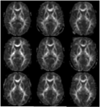Diffusion Tensor Imaging in Preclinical Huntington's Disease
- PMID: 21415933
- PMCID: PMC3057188
- DOI: 10.1007/s11682-008-9051-2
Diffusion Tensor Imaging in Preclinical Huntington's Disease
Abstract
Diffusion tensor imaging was used to study brain related changes in white matter that may be associated with Huntington's Disease progression. Thirty-one preclinical gene-mutation carriers were imaged cross-sectionally using diffusion tensor and anatomical brain imaging. Subjects were individuals who had a known gene mutation for HD but did not manifest motor diagnostic criteria for HD. Fractional anisotropy scalar maps showed a positive correlation with five year probability of diagnosis (based upon gene repeat length and current age) in the putamen and a negative correlation in the external capsule. This study shows that scalar maps generated from diffusion tensor imaging may be directly related to the earliest stages of disease progression within HD, even before a diagnosis is given. Findings suggest that DTI measures, therefore, may have the ability to act as a biomarker for disease progression in clinical trials of pre-manifest subjects.
Figures





References
-
- Aylward EH, Anderson NB, Bylsma FW, Wagster MV, Barta PE, Sherr M, et al. Frontal lobe volume in patients with Huntington's disease. Neurology. 1998;50(1):252–258. - PubMed
-
- Aylward EH, Sparks BF, Field KM, Yallapragada V, Shpritz BD, Rosenblatt A, et al. Onset and rate of striatal atrophy in preclinical Huntington disease. Neurology. 2004;63(1):66–72. - PubMed
-
- Bartzokis G, Lu PH, Tishler TA, Fong SM, Oluwadara B, Finn JP, et al. Myelin breakdown and iron changes in Huntington's disease: pathogenesis and treatment implications. Neurochem Res. 2007;32(10):1655–1664. - PubMed
-
- Basser PJ. Inferring microstructural features and the physiological state of tissues from diffusion-weighted images. NMR Biomed. 1995;8:333–344. - PubMed
-
- Beglinger L, Nopoulos P, Jorge R, Langbehn D, Mikos A, Moser D, et al. White matter volume and cognitive dysfunction in early Huntington's disease. Cogn Behav Neurol. 2005;18(2):102–107. - PubMed
Grants and funding
LinkOut - more resources
Full Text Sources
